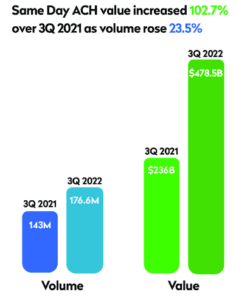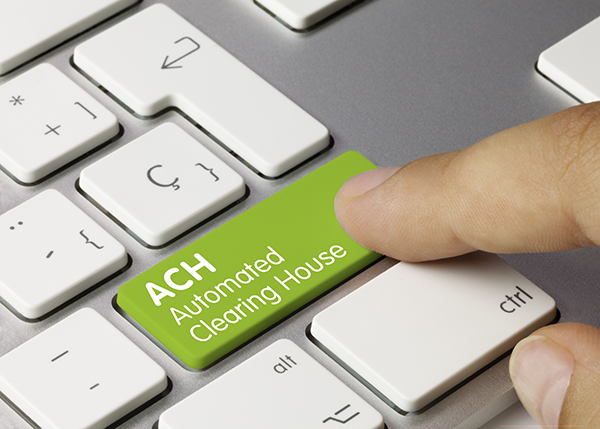ACH payments are a secure and convenient alternative to paper checks for businesses and consumers.
What is ACH?
ACH stands for Automated Clearing House. Automated Clearing House or ACH payments refer to the direct transfer of funds between two bank accounts.
Created in 1974 by the National Automated Clearing House Association (NACHA), the network over which ACH transactions are processed has seen tremendous growth. As a result, ACH payment volume reached 176.6 million transactions, totaling $478.5 billion in value in third quarter of 2022 alone.

Source NACHA
While not everyone will be familiar with the term ACH, almost everyone is familiar with the direct deposit of paychecks into their bank accounts. However, ACH payments go far beyond paychecks, providing various benefits to businesses and customers.
Seven Business Benefits of ACH payments
1. Lower fees
Merchants or organizations that accept card payments are very familiar with processing fees. There are processing fees on every debit and credit card sale. These processing fees are higher on cards that offer cashback or travel rewards and online transactions. However, the fees associated with ACH payments cost significantly less than the fees on credit cards.
Processing Cost Comparison
Credit and debit cards are the most expensive when comparing the fees for processing paper checks, credit and debit cards, and ACH payments. Debit and credit card fees are typically a percentage of the transaction and vary by card type and where the transaction occurs. At the same time, paper checks have the lowest transaction cost that can be more expensive overall due to the manual processing involved. In comparison, ACH payments are the least expensive payment method. Changing a merchants’ mix of payments to include a higher percentage of ACH payments significantly reduces their payment processing costs.
2. Security
According to the American Bankers Association; Check fraud accounted for forty-seven (47) percent of annual deposit account losses pre-pandemic — equating to a more than a $22 billion hit. Further, AFP Payments Fraud and Control Survey found paper checks accounted for sixty-six (66%) of all attempt/actual payment fraud in 2021. When a customer pays by paper check sent through the mail, several ways can compromise the check along the way.
First, the customer can lose the check going to mail it, or the post office could lose the check handling it.
Second, that check is handled by several different entities during processing making it vulnerable to signature forgery or tampering. Even worse is the potential for identity theft since the account and routing numbers plus the account owner’s name, phone, and address are typically visible on the check. Other common types of check fraud include. Check forgery, chemical alteration, paper hanging, and check floating.
When the customer’s check finally does arrive at the business, the risks continue. Again, using paper records and invoices increases the risk of fraud and error and puts your business out of PCI compliance. (PCI or compliance with payment industry standards is required if a merchant wishes to continue to process credit card payments).
Finally, ACH can eliminate the risks associated with storing checks before the deposit, including taking checks to the bank, physical loss, or misplacement, and eliminate the potential for theft.
ACH payments offer greater security than paper checks. ACH payments eliminate paper checks’ physical and security risks, giving consumers another way to pay. In addition, giving consumers more payment choices improves customer satisfaction and reduces the risk of moving to a competitor.
3. Convenience
ACH payments eliminate the need for customers to carry checkbooks or send paper checks in the mail. Customers want the flexibility and choice to make a one-time payment or set up recurring billing possible with ACH payments. Since ACH payments are transferred electronically, merchants eliminate the risks associated with paper checks and save money on postage, ink, transportation, and labor.
4. Risk reduction and time savings
ACH payments save merchants time, eliminate risk, and trips to the bank.
Since ACH payments are recorded in reports in modern payment processing systems, they simplify reconciliation while reducing late, “Oops, I forgot to mail the check” payments saving valuable time. They also take less time to process, reduce the potential for human error and thereby eliminate the time required to fix mistakes, not to mention the money saved not sending paper invoices.
5. Recurring billing
ACH payments are an excellent option for merchants with ongoing customer payments or a subscription-based business model.
As an owner of a business that regularly bills its customers, you have a few things to consider. First, every transaction has a cost; increasing the number of transactions and processing costs can skyrocket. Payment processing costs impact margins when the merchant’s payments mix is heavy on credit cards or online sales. Interchange rates are higher on sales made with rewards cards and online sales due to the increased risk of fraud.
Second, your customers may forget to pay their bills or pay them late, resulting in unpaid invoices and cash flow issues. Third, the manual processes and risks associated with paper checks, and fourth, the costs associated with credit cards typically used for recurring billing. ACH payment processing fees are low, helping merchants reduce their costs on each transaction. Over time, these savings per transaction can add up, significantly affecting the merchant’s margins.
6. Faster processing time
Unlike a mailed paper check, which must go through the mail, an ACH payment is paid online, speeding deposits. Banks see ACH payments as preferred funding over paper checks, which means a bank will process an ACH payment before a paper check. This means merchant funds are deposited faster by ACH than a traditional check.
7. Consumers prefer ACH over paper checks
Finally, consumers prefer ACH payments over paper checks.
As reported in the 2019 Federal Reserve Payments Study, paper check transactions fell by half from 40 billion in 2000 to less than 20 billion in 2018. Further, the number of checks being written is dropping by 1.8 billion a year, and at that rate, checks would go away entirely by 2026, according to Business Insider.
From 2015 to 2020, ACH transactions grew at a CAGR of 6%. Moreover, the growth in ACH transactions shows no sign of slowing. For example, the fourth quarter of 2021 was up 6.1% over the same period in 2020, according to NACHA.
Payment Trends
It makes sense that consumers prefer ACH over traditional paper checks. There are no checks to order, buy, write out, and mail. Plus, the recurring billing feature of ACH payments takes the stress out of remembering to pay their bill each month, the number one reason for late or missed payments. Further, since ACH payments are secure electronic transactions, consumers may feel better about paying and be more likely to buy when multiple payment options are offered.
ACH payments work for both merchants and their customers
ACH payments offer both merchants and customers ways to save time and money while reducing identity theft and fraud risks.
ACH, recurring payments and IntelliPay
IntelliPay offers merchants a variety of standalone and integrated ways to accept one-time and recurring ACH payments. Plus, for the 63 million un or underbanked Americans, we offer eCash, a way of paying online with cash. For more information about IntelliPay payment options, ACH, and eCash, visit www.intellipay.com or talk to one of our consultants.


